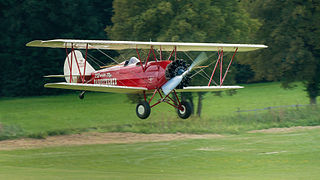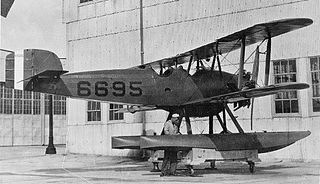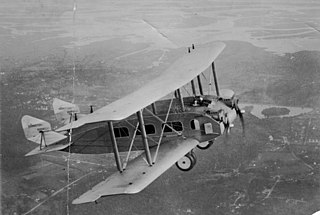
The Pitts Special is a series of light aerobatic biplanes designed by Curtis Pitts. It has accumulated many competition wins since its first flight in 1944. The Pitts biplanes dominated world aerobatic competition in the 1960s and 1970s and, even today, remain potent competition aircraft in the lower categories.

The Arrow Sport was a two-seat sporting biplane aircraft built in the United States in the 1920s and 1930s.

The Travel Air 2000/3000/4000 (originally, the Model A, Model B and Model BH were open-cockpit biplane aircraft produced in the United States in the late 1920s by the Travel Air Manufacturing Company. During the period from 1924–1929, Travel Air produced more aircraft than any other American manufacturer, including over 1,000 biplanes. While an exact number is almost impossible to ascertain due to the number of conversions and rebuilds, some estimates for Travel Air as a whole range from 1,200 to nearly 2,000 aircraft.

The Supermarine Seal II was a British flying boat developed by Supermarine after it secured a British Air Ministry order for a prototype three-seater fleet spotter amphibian. The prototype, which had to be capable of landing on Royal Air Force (RAF) aircraft carriers, was designed by Supermarine's R.J. Mitchell, who incorporated suggestions made after the Supermarine Commercial Amphibian achieved second place after it was entered for an Air Ministry competition in 1920.

The Loening C-2 Air Yacht was an amphibious airliner produced in the United States at the end of the 1920s, developed from the OL observation aircraft the firm was producing for the US military.

The Mutual Blackbird was a late 1920s two-seat open cockpit sporting biplane.

The American Eagle A-129 was an American biplane first flown in 1929.

The Waco 9 is an American-built three-seat biplane design that first flew in 1925.

The Waco Mailplanes are a range of two US-built open-cockpit mail biplane designs of the late 1920s.

The Alliance A-1 Argo was an American-built two-seat biplane of the late 1920s.

The Bell 30 was the prototype for the first commercial helicopter, and the first helicopter built by the Bell Aircraft Company. Designed by Arthur M. Young, the type served as a demonstration testbed for the successful Bell 47.

The Naval Aircraft Factory N2N was an American two-seat open-cockpit primary training biplane designed and built by the Naval Aircraft Factory. The N2N could be fitted with twin-floats and was powered by a 200 hp Lawrance J-1 radial engine, only three N2N-1s were built.

The Anderson Z is an early 1930s American-designed single-engine biplane.

The Spartan C2 is a light aircraft produced in the United States in the early 1930s as a low-cost sport machine that would sell during the Great Depression.

The Driggers D1-A is an American-built light high-wing single-seat sporting monoplane of the late 1920s.

The Burnelli RB-1 was a US twin engine biplane airliner prototype from 1920, incorporating a lifting body fuselage.

The FVM Ö 1 Tummelisa is a single seat, single engine Swedish biplane from the 1920s. It was operated by the Swedish Air Force as its advanced trainer until the mid-1930s.

The Williams-Cangie WC-1 Sundancer is an American homebuilt biplane racing aircraft that was designed by Art Williams and Carl Cangie and built by Ralph Thenhaus in 1974. Plans were at one time available from Williams' company, the Williams Aircraft Design Company of Northridge, California. Only one was built.

The Loening C-1 Air Yacht was an amphibious airliner produced in the United States at the end of the 1920s.

The Wiley Post Model A is a U.S. two seat sports biplane, built in small numbers in the 1930s.




















